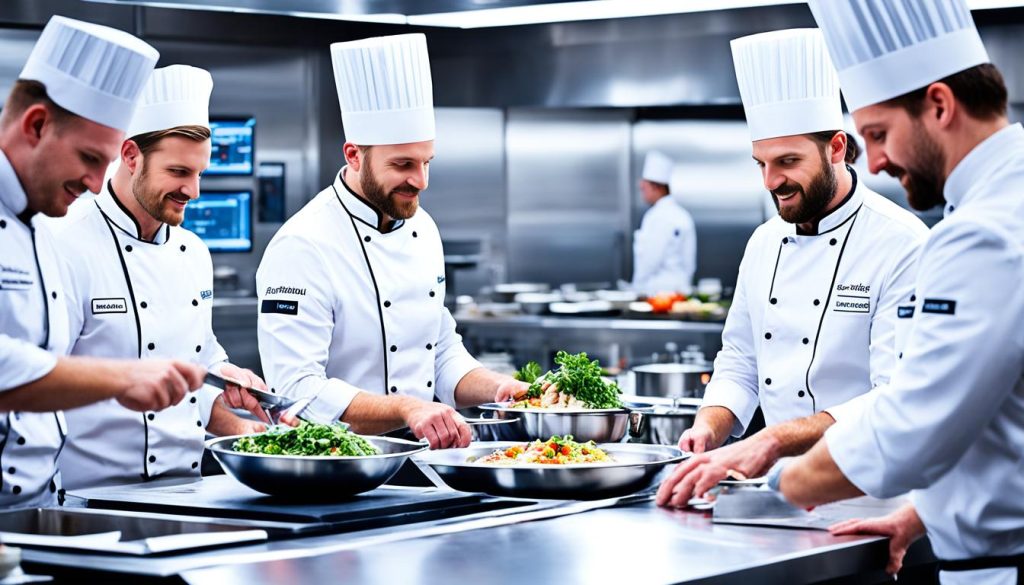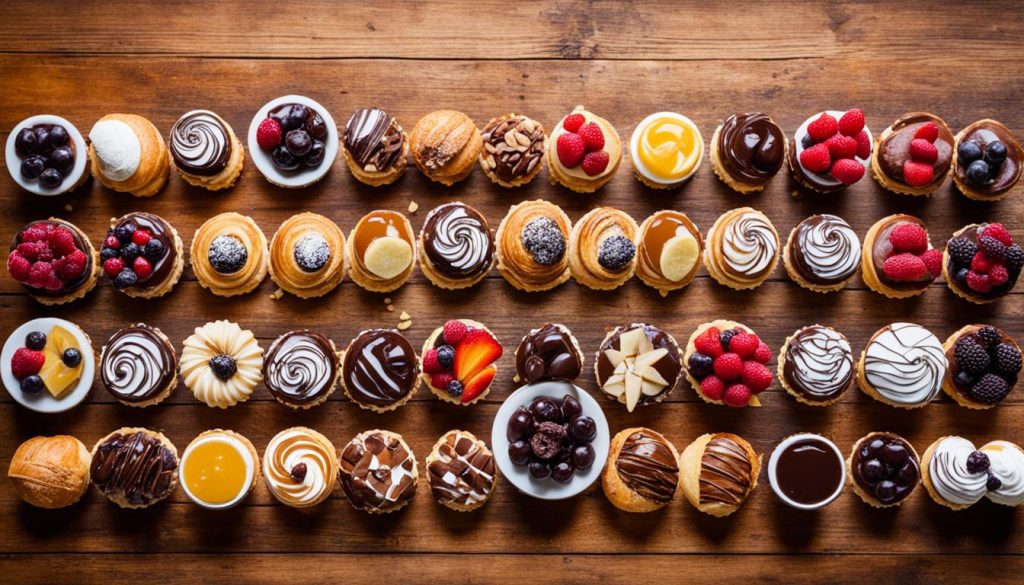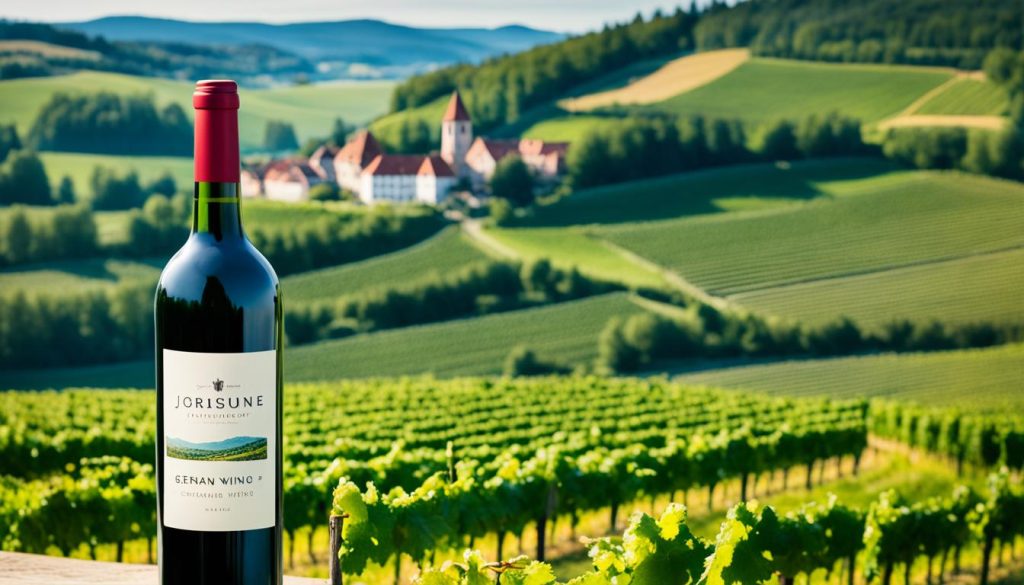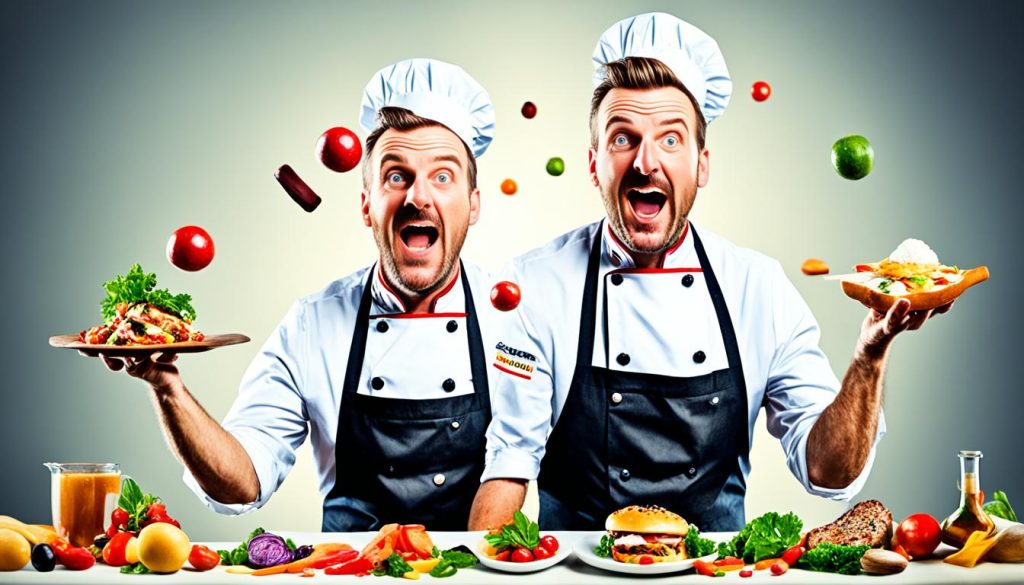In this article, we explore the exciting world of German food innovations. We will look at the unique tastes, methods, and meals coming out of Germany. These have greatly influenced cooking worldwide.
Key Takeaways:
- German cuisine has made significant contributions to global culinary innovations.
- Germany is known for its reinvention of traditional dishes.
- The rise of plant-based German cuisine reflects changing culinary trends.
- German culinary techniques continue to push the boundaries of creativity.
- German craft beer and artisanal spirits are gaining worldwide recognition.
The Influence of German Cuisine on European Gastronomy
German cuisine has greatly influenced European food. Its history and culture have molded the flavors of nearby countries.
Germany’s diverse food comes from its regions and neighbors like France and Italy. This mix has created a rich and exciting food scene in Europe.
German food stands out for its quality and traditions. Think of tasty sausages, pretzels, and the famous Black Forest Cake. These dishes show the craftsmanship and care found in European cooking.
Germans focus on fresh and local ingredients. This shows their commitment to sustainability and quality. It’s a practice now embraced by restaurants across Europe.
German cuisine uses herbs and spices expertly, making dishes bold and flavorful. The mix of sweet, sour, salty, and umami tastes has influenced European flavors.
German food’s impact is seen across Europe. It has influenced everything from French sausages to Italian pasta.
To fully understand German cuisine’s role, one should try its dishes. Experiencing a Bavarian Sauerbraten or a slice of Schwarzwälder Kirschtorte shows how it shapes European tastes.
Reinventing Traditional German Dishes
German dishes like sauerkrait, schnitzel, and bratwurst have special places in our hearts. But, chefs in Germany are now changing these old favorites. They’re adding new life and creativity to traditional recipes.
These changes show how food constantly evolves. Chefs use new methods, ingredients, and presentations. They aim to create modern dishes that still honor German culinary traditions.
Sauerkraut has gotten a makeover. Once just a sour side dish, it’s now in pancakes, dumplings, and even ice cream. These new sauerkraut dishes surprise and delight diners with their innovation.
Schnitzel, too, has changed. Chefs are making vegan and vegetarian versions with tofu or plant proteins. This new take on schnitzel meets the demand for meat-free options.
Bratwurst is being reinvented as well. Chefs mix in different meats, herbs, and spices. There are now bratwursts with cheese, bacon, or fruit inside, offering exciting new flavors.
The Creative Reinvention of Traditional German Dishes
Reinventing German food is about more than new recipes. It’s a celebration of Germany’s food heritage mixed with creative thinking. Chefs blend traditional and international flavors and reimagine how dishes are presented.
This new approach has made more people excited about German food. It appeals to young diners looking for unique eating experiences.
The Future of Reinvented German Cuisine
Chefs keep exploring and innovating German food. As diners grow more adventurous, they crave these new culinary creations. The journey of reinventing German dishes is far from over.
Chefs are leading a rebirth of German cooking. They’re drawing food lovers from everywhere to enjoy the mix of old and new.
The Rise of Plant-based German Cuisine
Germany is seeing a big change with more plant-based foods in its cooking scene. This is because people want meals that are good for them and the planet. Many chefs are now making classic German meals with plants instead.
These chefs use local veggies and new ways of cooking to make tasty dishes. You can find everything from colourful salads to vegan sausages. These dishes are not just good to eat. They also help the environment.
Chefs are using ingredients like seitan and tofu to make their meals rich and full of flavour. They also use spices like caraway seeds to make the food taste great. This makes plant-based German food really interesting to try.
Take the “Krautburger” for example. It’s a plant-based version of the German hamburger. It has sauerkraut, mushrooms, and lentils on a wholegrain bun. This shows how versatile plant-based food can be.
And it’s not just about savoury food. Pastry chefs are making vegan desserts that are yummy. There’s vegan Black Forest gateau and dairy-free apple strudel. You can enjoy these treats without feeling guilty.
Trying plant-based German food is great for the planet and for finding new favourite dishes. Whether you’re vegan or just curious, these meals will surely impress you.
The Fusion of German and International Flavours
German cuisine has started mixing with tastes from around the world. German chefs now use global techniques and ingredients. This creates exciting and unique dishes.
German and Asian flavours are being combined in amazing ways. Tim Raue, a famous German chef, leads in German-Asian fusion. His restaurant in Berlin, “Restaurant Tim Raue,” shows how well German and Chinese tastes can blend. His “Peking duck with red cabbage and plum sauce” is a perfect example.
Mexican and German cuisines have also been brought together. In Munich, “Los Borrachos” blends German beer with Mexican food brilliantly. The menu has “Schnitzel Tacos” and “Beer-Braised Carnitas,” a clever mix of flavours.
German and Italian flavours are merging too. “Il Mercato” in Frankfurt makes dishes that mix these cuisines beautifully. “German Sauerbraten Ravioli” and “Italian-Style Currywurst” are great examples. They provide a special eating experience.
The Fusion of German and International Flavours – A Culinary Journey
Start a culinary journey with the fusion of German and international tastes. Enjoy the new dishes famous chefs have made. These dishes bring together different culinary traditions. This creates a dining adventure that’s truly unique. Enjoy this blend of flavours that shows the global side of German cuisine.
| Cuisine | German Ingredients | Global Influences |
|---|---|---|
| German-Asian Fusion | Sauerkraut, Bratwurst, Red Cabbage | Soy Sauce, Ginger, Rice Vinegar |
| Mexican-German Fusion | Schnitzel, Bratwurst | Avocado, Chipotle, Salsa |
| German-Italian Fusion | Sauerbraten, Currywirtschaft | Pasta, Tomato Sauce, Parmesan |
Modern German Street Food
Street food in Germany is now more innovative, with new stalls and trucks appearing in cities. Explore this lively scene, from unique currywurst to tasty Döner kebabs.
German street food blends traditional tastes with worldwide flavors and techniques. Vendors are updating classic dishes, attracting locals and tourists with their inventive food.
The currywurst has gotten a modern update. This German fast-food favorite is usually sausages with tomato sauce and curry powder. Now, vendors are getting creative with different sausages, homemade sauces, and toppings. You can find vegan options or fusion currywurst with Asian spices.
The Döner kebab, originally from Turkey, is a key part of German street food. It’s made of roasted meat strips, like lamb or chicken. Today, vendors add unique fillings and toppings to Döner kebabs. You can enjoy falafel, tzatziki, grilled veggies, and spicy sauces.
German street food isn’t just about updated classics. It now features international influences. You might see tacos with sauerkraut and pork schnitzel or bao buns with bratwurst and kimchi. These dishes show the diversity and creativity in modern German street food.
Discovering modern German street food is an exciting adventure. The smells of grilling sausages and the look of fresh toppings make every bite special. For food lovers, travelers, or anyone wanting a tasty meal, modern German street food is a wonderful mix of old, new, and a dash of magic.
Cutting-edge German Culinary Techniques

German culinary skills are known for precision and quality. Recently, German chefs have been innovating, moving beyond traditional ways. Techniques like molecular gastronomy and sous vide have changed the German food scene, taking it to new heights.
Molecular Gastronomy
Molecular gastronomy is a thrilling new step for German cooking. It’s a mix of science and creativity, making amazing dishes. Chefs use techniques like spherification to turn simple ingredients into unforgettable meals. This approach doesn’t just make food taste great, it also looks incredible.
Sous Vide Cooking
Sous vide, or “under vacuum,” cooks food sealed in a bag at a set temperature in water. It’s a favorite among German chefs for how well it cooks everything, from meat to desserts. This technique ensures food is flavorful and tender. It’s common in top German restaurants for its consistent and delicious results.
| Benefits of Molecular Gastronomy | Benefits of Sous Vide Cooking |
|---|---|
| Enhances creativity in food presentation | Consistent results every time |
| Intensifies flavors and textures | Retains nutrients and natural juices |
| Allows for unique flavor combinations | Precise control over cooking temperature |
| Creates memorable dining experiences | Reduces food waste |
These new methods have touched not just fancy restaurants but also home kitchens in Germany. More people are trying out molecular gastronomy and sous vide at home. They’re excited to experiment with these modern cooking ways.
German cooking is always changing, mixing new techniques with traditional ones. Chefs strive for the best, creating a blend of the old and new. This mix of tradition and innovation makes German food exciting, whether in fancy restaurants or at home.
German Craft Beer and Artisanal Spirits
Germany is famous for its brewing and world-class spirits. While many think of its beer festivals and iconic brands, the country’s craft beer and artisanal spirits scenes are making waves. Microbreweries and distilleries in Germany are creating unique, small-batch drinks that are gaining fans all over the globe.
German craft beer is where tradition meets innovation. Its brewers use old brewing techniques but also try new things for unique tastes. You can find a variety of beers, like refreshing pilsners, rich stouts, or aromatic IPAs. They focus on quality ingredients and careful brewing to make sure every beer tastes great.
Artisanal spirits show the skill and care of German distillers. These drinks are more unique than mainstream ones, offering a distinct drinking experience. You might try a gin with local botanicals or a whisky aged just right. Each sip shows the passion and artistry of the distillers.
The Craft Beer Renaissance
The craft beer movement in Germany is part of a global trend towards unique and independent brews. Craft brewers are experimenting with hops, yeast, and malts to create their own styles. They make small batches that get a lot of attention, ensuring high quality.
Traditional German beer styles are getting a new life with a modern twist. Breweries are updating classics like hefeweizen and bock beer, while keeping them authentic. These beers blend tradition with a modern touch, appealing to both purists and new fans.
The Art of Artisanal Spirits
Artisanal spirits are made by dedicated distillers who closely manage every production step. They prefer small batches for better control and precision. These distillers use a variety of ingredients and aging methods to create spirits that reflect their vision and skill.
German distillers are taking traditional spirits like gin and brandy to the next level. They add unique, local flavors, making spirits that truly represent their region. Their commitment to craftsmanship and quality makes these artisanal spirits a must-try for anyone who loves good drinks.
Exploring German Craft Beer and Artisanal Spirits: A Tasting Journey
To get to know the diversity and quality of German craft beer and spirits, try tasting them for yourself. Whether you’re well-versed in drinks or just starting, trying different German beers and spirits can deepen your appreciation. It’s a great way to explore these special beverages.
Below is a table that highlights some notable German craft breweries and distillaries, along with their signature offerings:
| Brewery/Distillery | Signature Offerings |
|---|---|
| Stone Brewery Berlin | Arrogant Bastard Ale, Stone IPA, Berlin Pale Ale |
| BRLO Craft Beer | Helles Lager, Pale Ale, German IPA |
| Braufactum | Progusta IPA, Roog Smoked Bock, The Brale |
| The Duke Gin | The Duke Munich Dry Gin, The Duke Rough Gin, The Duke Wanderlust Gin |
| Stork Club | Single Malt Whisky, Dry Gin, Grains Vodka |
| Monkey 47 | Monkey 47 Schwarzwald Dry Gin |
Start your tasting journey with German craft beer and spirits. Whether you favor beer or spirits, these unique drinks will surely please you. They offer a chance to experience the finesse of German craftsmanship.
Sustainable and Locally-sourced German Cuisine
Sustainability and locally-sourced ingredients are core to German cuisine. Chefs and restaurants across Germany are adopting eco-friendly practices. They make tasty dishes that help our planet.
German chefs focus on sustainability. They use local ingredients, cutting down food miles and supporting local farmers. This keeps traditional German flavours alive and connects diners with their communities.
Chefs in Germany love using seasonal produce. They add locally-grown fruits and veggies to their dishes. So, summer brings salads full of tomatoes and cucumbers, while autumn introduces stews with root veggies and mushrooms. Every meal showcases regional abundance and seasonal tastes.
Many restaurants in Germany are also fighting food waste. They get creative with leftovers, making new, tasty dishes. This lowers their environmental footprint and leads to exciting flavours.
Celebrating Sustainable Seafood
Germany cares about sustainable seafood too. Its coastal areas support responsible fishing. This helps protect marine life. Chefs serve locally-caught, sustainable fish, bringing the essence of the North and Baltic Seas to the plate.
This approach helps the environment and supports local fishermen. It lets diners enjoy seafood that’s both traceable and ethically-sourced. It deepens the bond between them, the ocean, and its bounty.
The focus on sustainability in German cuisine not only makes dining out special. It also shows Germany’s commitment to looking after the environment and supporting communities. German chefs and restaurants lead by example, proving good food and caring for the planet can go together.
German Desserts and Pastry Innovations

German desserts and pastries are known for their delicious tastes and detailed designs. The Black Forest cake offers a rich, chocolatey treat. The Baumkuchen has delicate layers that dessert lovers worldwide adore.
The strudel is a classic German pastry, loved for its light pastry shell and tasty fillings. The Apfelstrudel combines tart apples and sweetness perfectly. Nowadays, it comes with new fillings like berries or even spinach and feta for a twist.
Germany offers a paradise for sweet tooths with its dessert innovations. Pastry chefs there are mixing old recipes with new, surprising ingredients. They bring a modern flare to the traditional, making each dessert unique.
A fantastic innovation is blending German desserts with global flavors. Chefs use foreign ingredients and methods to make exciting new desserts. Imagine a tiramisu inspired by the Black Forest cake or a marzipan macaron filled with custard. These combinations offer a fresh and delightful experience.
Unique German Pastry Creations
German pastry chefs are also known for their creative desserts. They use seasonal fruits, herbs, and spices to enhance traditional desserts. The German plum cake is a perfect example, turning plums into a sweet and tangy delight.
Besides, German patisseries are focusing on healthier options without losing the taste. They explore gluten-free, vegan, and organic recipes. This means everyone can enjoy a piece of German pastry heaven, regardless of their diet.
German Dessert Table
| Dessert | Description |
|---|---|
| Black Forest Cake | A luscious chocolate cake layered with cherries and whipped cream, garnished with chocolate shavings |
| Stollen | A traditional Christmas fruitcake filled with dried fruits, nuts, and spices, often dusted with powdered sugar |
| Bienenstich | A honey-flavored pastry filled with a creamy custard and topped with caramelized almonds |
| Schwarzwälder Kirschtorte | A classic German dessert consisting of chocolate sponge cake, cherry filling, and whipped cream |
| Lebkuchen | Soft gingerbread cookies flavored with a blend of spices, often enjoyed during Christmas |
German pastry innovations keep amazing those who love desserts. Whether you prefer sticking to traditional recipes or exploring new flavors, German desserts offer a world of joy and creative tastes.
The Influence of German Michelin-starred Restaurants
German Michelin-starred restaurants are world-renowned, attracting food lovers with their top-notch dishes and creative flair. They mix traditional German tastes with new methods. These places have transformed German food and won global praise.
Famous chefs, like Joachim Wissler, have been crucial in evolving these restaurants’ offerings. His place, Vendôme in Bergisch Gladbach, has earned three Michelin stars for its top-quality food. It shows off the skill and sophistication of German cooking.
Sven Elverfeld, who runs Aqua in Wolfsburg, is another key chef. His forward-thinking cooking and focus on the best local ingredients have made Aqua a leader in fine dining.
These restaurants are not just about the food; they also offer unique dining experiences. Whether it’s Restaurant Bareiss’s elegant setting or Schloss Schauenstein’s contemporary vibe, each has a special atmosphere that enhances the meal.
The Michelin Guide’s Recognition of German Culinary Excellence
The Michelin Guide is seen as the top authority on gourmet dining and has praised German Michelin-starred restaurants. This recognition draws foodies and travellers to Germany to explore its culinary riches.
These restaurants excel at combining old and new. They update German classics, adding contemporary twists while keeping true to original tastes. This approach offers diners a mix of familiar and new flavors.
Exploring German Michelin-starred Restaurants: A Gastronomic Journey
A culinary trip to these restaurants is a deep dive into Germany’s varied regional foods and cooking methods. From Bavarian treats at Gasthof zum Bad to sophisticated dishes at Restaurant Überfahrt, each offers a taste of Michelin-starred excellence.
| Restaurant | Location | Michelin Stars |
|---|---|---|
| Vendôme | Bergisch Gladbach | 3 |
| Aqua | Wolfsburg | 3 |
| Restaurant Bareiss | Baiersbronn | 3 |
| Schloss Schauenstein | Fürstenau | 3 |
Visiting German Michelin-starred restaurants is a journey through flavor and creativity. Each dish is a chance to see the chefs’ unmatched talent. With every bite, diners experience the pinnacle of German cuisine, from light seafood to hearty stews. It’s a dining event that makes a memorable impact.
The Rise of German Food Festivals
Germany has seen a huge rise in food festivals recently. These events celebrate the rich and varied food scene. From old classics to new treats, they are a feast for anyone who loves food.
At these festivals, you can enjoy local dishes, street food, cooking contests, and famous chefs. They allow talented chefs to show off and amaze everyone with their cooking. It’s a perfect way to see the skill and love in German food.
Oktoberfest is a must-see festival in Germany. Though it’s famous for beer, the food is just as impressive. You’ll find delicious sausages, pretzels, sauerkraut, and schnitzels there.
The Street Food Festival is another major event. Here, you get to try international and German street foods. You’ll find spaetzle, pork belly, currywurst, and Berliner doughnuts. The lively vibes and delicious smells make it unforgettable.
These festivals aren’t only for eating. They’re also a chance to learn about German cooking traditions. Many have cooking showcases by top chefs. It’s fun and you might learn some kitchen secrets.
Experiencing a German food festival is essential to understand the country’s cuisine. It lets you dive into the food culture, try different tastes, and find Germany’s culinary treasures. So, get ready for an amazing food journey at a German festival.
German Wine Revolution

Germany’s wine industry has seen huge changes, leading to the German wine revolution. Innovative winemakers are breaking the mold and making amazing wines. These wines are as good as the world’s best.
Different regions in Germany bring unique flavors to their wines. The Mosel Valley has steep slopes, while Baden is sunny. Each area’s features help make unique, flavorful wines. Germany’s climate is perfect for a variety of grapes, creating different wine styles.
Germany is also trying new grape types, not just sticking to Riesling. Winemakers are using Pinot Noir, Silvaner, and Müller-Thurgau. This means wine lovers now have more choices and styles to enjoy.
Winemakers are using new and old techniques to make their wines stand out. They’re farming organically and with little intervention. This makes wines that really show off where they’re from. The winemakers’ passion and creativity shine through.
The German wine revolution has changed how people see German wines globally. With its rich history and modern innovation, Germany is a top wine producer. Wine lovers everywhere are taking notice.
| German Wine Regions | Notable Grape Varieties |
|---|---|
| Mosel | Riesling |
| Baden | Pinot Noir (Spätburgunder) |
| Rheingau | Riesling, Pinot Noir |
| Pfalz | Riesling, Pinot Noir |
| Franconia (Franken) | Silvaner |
Germany’s winemaking is going through exciting changes. It’s a great time for wine fans to check out Germany’s diverse, top-notch wines. The revolution showcases the winemakers’ hard work and innovation.
Exploring German Culinary Innovations Beyond the Plate
Germany leads in sustainable food practices, education, and culinary tourism. The country is a global front-runner in sustainable food systems. It focuses on local, organic ingredients and cutting food waste. German chefs and food entrepreneurs are transforming food production and consumption through initiatives like farm-to-table and community-supported agriculture.
Germany shines in food education and culinary arts too. Across the country, cooking schools and workshops teach German cooking skills. They also promote creativity in cooking. German chefs are mixing traditional recipes with new techniques and flavours from around the world.
Culinary tourism highlights German gastronomy. Food tours let visitors explore local markets, breweries, and vineyards. They learn about the area’s rich culinary history. Germany’s food experiences range from wine regions like Mosel and Rheingau to vibrant food markets in Berlin and Munich. These are not limited to eateries alone.
German culinary innovations are about more than food on a plate. They involve a comprehensive approach to food that values sustainability, education, and cultural heritage. Germany’s commitment inspires worldwide chefs and food lovers towards a conscious and innovative food culture.
















